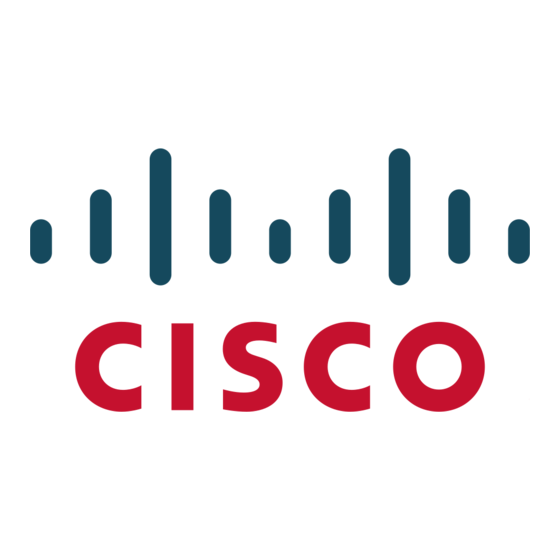Cisco 7246 - uBR Router Manual del usuario - Página 5
Navegue en línea o descargue pdf Manual del usuario para Hardware de red Cisco 7246 - uBR Router. Cisco 7246 - uBR Router 7 páginas. 7200 series port adapter hardware configuration guidelines
También para Cisco 7246 - uBR Router: Configuración de (28 páginas), Manual complementario (42 páginas)

– Network Boot support all port adapters that are traditionally supported in Boot images. This does not include network Boot support
for the Cisco uBR-MCxx line cards, which have never been supported in Boot images.
b) I/O Boothelper image for predecessor NPEs to the Cisco uBR7200-NPE-G1:
– ubr7200-boot-mz.122-yy.BC.bin (where yy = Cisco IOS Release 12.2BC)
– Boot image for predecessor NPEs to the Cisco uBR7200-NPE-G1
– Loads on I/O controller card limited to 4 MB of Flash
– Besides the restrictions of the "kboot" image, this image does not support network Boot of the following port adapters: 4T, CT1, CE1,
M4T, M8T, HSSI, DSX1, CT3, ME1, JT2, E3T3, E1T1, ATM 4T1, ATM 4E1, Voice, Ch-STM-1. Essentially, this boils down to no
serial port adapters, no voice, and limited ATM support.
Q. How much NVRAM is available on the Cisco uBR7200-NPE-G1?
A. The NVRAM on the Cisco uBR7200-NPE-G1 has been increased to 512 Kbytes. This increase in NVRAM means that larger
configuration files can be saved on the Cisco uBR7200-NPE-G1. The increase in NVRAM is due to frequent requests from service provider
customers who often run extremely large configuration files. The NVRAM is physically located on the Cisco uBR7200-NPE-G1, not on the
Cisco I/O controller as with other NPEs. Router configuration follows the Cisco uBR7200-NPE-G1 if you move it to another chassis. If you
are upgrading from an older NPE, save your current configuration to a Flash disk first. You will not be able to access the old one once the
Cisco uBR7200-NPE-G1 is installed.
Q. What Flash options are available with the Cisco uBR7200-NPE-G1?
A. A Cisco uBR7246VXR has two basic types of Flash media: Boot Flash and removable Flash media.
Boot Flash is non-removable and is usually located on the Cisco I/O controller in a system. When a Cisco uBR7200-NPE-G1 is used in
combination with a supported I/O controller, the Boot Flash present on the Cisco uBR7200-NPE-G1 will be used. The Cisco
uBR7200-NPE-G1 comes with 16 MB of Boot Flash. This cannot be upgraded or changed as it is fixed on the system board.
The second type of Flash media available on the Cisco uBR7246VXR is Removable Flash media. These are available in either PCMCIA size
Flash cards or Compact Flash cards. An I/O controller in a Cisco uBR7200-NPE-G1 system will support PCMCIA Flash (or Compact Flash
with the appropriate adapter). Most Cisco I/O controllers also support both Linear Flash media and ATA Format Flash disk, (slot0: vs disk0:)
in sizes from 8 MB to 128 MB.
The Cisco uBR7200-NPE-G1 also supports Removable Flash media in the form of Compact Flash cards. These cards are ATA format and
can also be used in other ATA compatible systems. The Cisco uBR7200-NPE-G1 supports Compact Flash sizes from 64 MB to 256 MB. The
compact flash card on the Cisco uBR7200-NPE-G1 can be accessed whether or not there is a Cisco I/O controller installed in the chassis. The
Compact Flash card must be formatted on a Cisco uBR7246VXR before use. Do not format the Compact Flash card on a PC or laptop. The
Compact Flash card may be read or written using a PC or laptop with the appropriate PCMCIA connectors.
Q. How is backplane bandwidth sharing among port adapters and line cards different with a Cisco uBR7200-NPE-G1 enabled system?
A. Since the Cisco uBR7200-NPE-G1 utilizes a different architecture than previous NPEs, the concept of sharing backplane bandwidth is
slightly different in a Cisco uBR7200-NPE-G1 enabled system. This is because the Cisco uBR7200-NPE-G1 comes with three 10/100/
1000Mb Ethernet ports fixed to the NPE, as well as a dedicated PCI connection to the I/O controller slot. These Ethernet ports feed directly
into the CPU without consuming any bandwidth from the system PCI buses. With that much LAN/WAN connectivity built into the Cisco
uBR7200-NPE-G1, the traditional port adapter slots are now freed up. Only the port adapters and the optional I/O controller consume PCI
bus bandwidth.
A first for the Cisco uBR7200-NPE-G1-enabled Cisco uBR7246VXR is a dedicated PCI bus for the I/O controller. With previous NPEs, the
I/O controller shared PCI bus bandwidth with three of the port adapter and line card slots. That meant that any interfaces on the I/O
controller subtracted from the bandwidth available for three of the port adapter and line card slots. With the latest generation of 2xFE/E I/
O controller, this becomes a greater concern with the large amount of bandwidth required for the I/O controller. With the introduction of
the Cisco uBR7200-NPE-G1, the I/O controller is placed on its own, dedicated PCI bus. That means that any interfaces on the Cisco I/O
controller will no longer steal bandwidth from any of the port adapter and line card slots.
All contents are Copyright © 1992–2002 Cisco Systems, Inc. All rights reserved. Important Notices and Privacy Statement.
Cisco Systems, Inc.
Page 5 of 7
